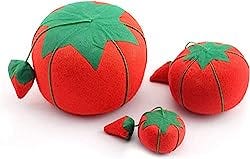There are lots of sewing tools to choose from. So what are the 5 types of sewing tools? You might get overwhelmed on what to buy, but sewing doesn’t have to be complicated. Here is my list.

This is another article in my Basics of Sewing series.
To get started in sewing, you need some basic supplies such as scissors, an iron, and needles. Optional items include a sewing machine, a cutting mat, and a rotary cutter. These items can often be expensive, but there are cheaper alternatives to every tool that you can buy. But there are also a lot of expensive tools out there! In my opinion, you don’t need a lot of expensive items to get started on your sewing projects. These types of sewing tools are what I would consider the “bare minimum.”
What are the 5 types of sewing tools? These are:
Contents
Marking Tools
Marking tools are what you use to “draw” on fabric. Most sewing patterns come, at the minimum, with the basic shape that you will need to cut out of the fabric. Other sewing patterns have symbols that make your life easier if you transfer them to the fabric. You can actually just use a lead pencil because the graphite is machine washable. I find that keeping a cup of #2 pencils on my desk is handy not just for sewing and crafting.
You can also use fabric chalk. I love these things because they are efficient and cheap. The markings also wash out of fabric. However, chalk can be bulky to use and is often not as precise as you may want.

Which brings us to washable markers — or, and I absolutely love these — heat erasable markers. Which means you can iron the marks out.

By the way, you can also just use Crayola markers as long as they are machine washable. This is a good option for those of us with small children (or if you just like to doodle or bullet journal).
Measuring Tools
The next type of tool that you need is something to measure with. At the very least, you need a simple ruler. I like those silicon flexible ones, but you can get away with a measuring tape (like the type you use to do home improvements) or a wood/metal one.
At some point, though, you will need a flexible measuring tape, which is useful for measuring the circumference of objects, e.g. your waist.

I find that my acrylic grid ruler is indispensable. Really, you will not need anything else. Mine is kind of becoming frayed around the edges (as it has paper underneath for the markings, which also helps so it doesn’t slid on your fabric), but it has lasted me over ten years.

Speaking of quilting, one of the best measuring tools (and I think anyone who wants to sew should own it) is a quilters’ cutting map, ruler, and rotary cutter combo.

Cutting Tools
Okay, here’s the thing. You can’t use regular scissors to cut fabric. They don’t cut it. (Okay, bad joke). You need a good pair of sewing shears. And, you can only use them to cut fabric. If you use them to cut anything else, even paper, then they will dull. And even sharpening your scissors will make them not work well. Some recommend to sharpen them when they get dull, but I think it’s easier and cheaper to just buy new ones. So don’t cut out patterns (even the tissue paper kind).

You’ll also need a pair of small snipping scissors (sometimes called embroidery scissors), which is great for thread, corners, and small details. You can also use these little scissors for cutting notches in your patterns instead of using a marking tool.

Also, don’t forget your rotary cutter! You can pick up some extra blades, too. A dull rotary cutter is no fun.

Pressing Tools
There isn’t much to say here. Just get a good iron. You need to wash and press most fabrics (although, don’t wash or press anything that requires dry-cleaning or isn’t supposed to be washed in a machine). Irons are, obviously, for getting rid of wrinkles. But also to press seams and direct the fabric.

Sewing Tools
Needles, needles, and more needles! You’ll need hand needles as well as machine needles. Also, you use different needles for different projects. But you should buy a set of generic needles for most sewing projects.

Also vital are sewing straight pins. Again, you have different kinds for different fabrics. But a generic set of straight pins always comes in handy.
And if you have straight pins, then you’ll need a pin cushion. I like the tomato pin cushion, but they come in all sorts of shapes and sizes!
But you can find almost all of these basic sewing supplies in a handy-dandy starter kit.
And you also will want a sewing machine.
Other Resources
Types of Sewing Machine That Are Most Useful and Popular
Stocking Your Tool Kit with the Other Essentials — Unique Sewing Tools & Their Uses













1 thought on “Beginner’s Bible: Learning What Are the 5 Types of Sewing Tools”